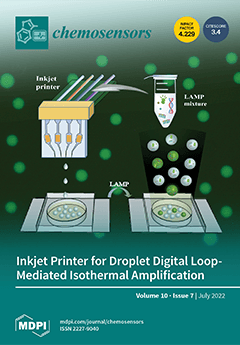Using the first-principles theory, this study explored the electronic behavior and adsorption effect of SO
2 on an InP
3 monolayer doped with transition metal atoms (Pd, Pt, Au, Fe, Co and Mo). Through calculation and analysis, the optimum doping sites of TM
[...] Read more.
Using the first-principles theory, this study explored the electronic behavior and adsorption effect of SO
2 on an InP
3 monolayer doped with transition metal atoms (Pd, Pt, Au, Fe, Co and Mo). Through calculation and analysis, the optimum doping sites of TM dopants on the InP
3 monolayer were determined, and the adsorption processes of SO
2 by TM-InP
3 monolayers were simulated. In the adsorption process, all TM-InP
3 monolayers and SO
2 molecules were deformed to some extent. All adsorption was characterized as chemical adsorption, and SO
2 acted as an electron acceptor. Comparing E
ad and Q
t, the order of the SO
2 adsorption effect was Mo-InP
3 > Fe-InP
3 > Co-InP
3 > Pt-InP
3 > Pd-InP
3 > Au-InP
3. Except for the Au atom, the other five TM atoms as dopants all enhanced the adsorption effect of InP
3 monolayers for SO
2. Furthermore, the analysis of DCD and DOS further confirmed the above conclusions. Based on frontier orbital theory analysis, it is revealed that the adsorption of SO
2 reduces the conductivity of TM-InP
3 monolayers to different degrees, and it is concluded that Pd-InP
3, Pt-InP
3, Fe-InP
3 and Mo-InP
3 monolayers have great potential in the application of SO
2 resistive gas sensors. This study provides a theoretical basis for further research on TM-InP
3 as a SO
2 sensor.
Full article





